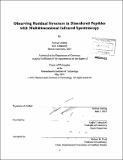| dc.contributor.advisor | Andrei Tokmakoff. | en_US |
| dc.contributor.author | Lessing, Joshua (Joshua Aaron) | en_US |
| dc.contributor.other | Massachusetts Institute of Technology. Dept. of Chemistry. | en_US |
| dc.date.accessioned | 2012-09-27T15:25:24Z | |
| dc.date.available | 2012-09-27T15:25:24Z | |
| dc.date.copyright | 2012 | en_US |
| dc.date.issued | 2012 | en_US |
| dc.identifier.uri | http://hdl.handle.net/1721.1/73361 | |
| dc.description | Thesis (Ph. D.)--Massachusetts Institute of Technology, Dept. of Chemistry, 2012. | en_US |
| dc.description | Cataloged from PDF version of thesis. | en_US |
| dc.description | Includes bibliographical references. | en_US |
| dc.description.abstract | An estimated 35% of the human proteome is intrinsically disordered. Disordered proteins play a key role in physiologic and pathologic regulation, recognition, and signaling making protein disorder the subject of increasing investigation. Since disordered samples do not generate x-ray quality crystals and since they have conformations that interconvert faster than the time resolution of NMR or ESR, little is known about their structure or function. By combining isotope-edited two-dimensional infrared spectroscopy (2D IR) with spectral modeling based on molecular dynamics simulations, this work will show that one can measure the residual structure and conformational heterogeneity of a putatively disordered sequence. This methodology was first used to study the structure and dynamics of the tryptophan zipper 2 (TZ2) peptide. The TZ2 peptide is a 12 residue engineered sequence that employs the "tryptophan zipper" motif to stabilize a p-hairpin fold. For this work five isotopologues of TZ2 were synthesized, the p-turn label K8, the midstrand labels T10 and T3T1O, the N-terminal label S1, and the unlabeled peptide UL. Temperature dependent FTIR and 2D IR studies in conjunction with modeling revealed that the TZ2 peptide at low temperatures exists as a folded peptide with a type I' turn and a small previously unobserved subpopulation of a bulged loop structure. Upon heating a fraying of the peptides termini is observed, in addition the population of the type I' turn increases relative to the population of the bulged turn. The TZ2 peptide provided a model hairpin system to test the utility of different forms of analysis and isotope labeling patterns for the subsequent study of disordered hairpin peptides. This methodology was next employed to gain insight into the structure of the elastin-like peptide GVGVPGVG, a prototypical disordered system. For this work nine isotopologues were studied in addition to size dependent variants based on the VPGVG sequence and point mutants variants of the form GVGXPGVG. The conformational ensemble was found to contain a high population of irregular P-turns possessing two peptide hydrogen bonds to the proline C=O (see figure below). Further, it was found that this population grows as a function of 1) side-chain volume for the peptide series GVGXPGVG, where X = Gly, Ala, and Val, and 2) polymer size for the peptide series GVG(VPGVG)a, where n = 1-6 and 251. These findings provide new insight into the molecular origin of the mechanical properties of biopolymers containing XPG turns including collagen (X = Pro), elastin (X = Val), mussel byssus (X = Gly), dragline spider silk (X = Gly), and wheat glutenin (X = Gln).` | en_US |
| dc.description.statementofresponsibility | by Joshua Lessing. | en_US |
| dc.format.extent | 225 p. | en_US |
| dc.language.iso | eng | en_US |
| dc.publisher | Massachusetts Institute of Technology | en_US |
| dc.rights | M.I.T. theses are protected by
copyright. They may be viewed from this source for any purpose, but
reproduction or distribution in any format is prohibited without written
permission. See provided URL for inquiries about permission. | en_US |
| dc.rights.uri | http://dspace.mit.edu/handle/1721.1/7582 | en_US |
| dc.subject | Chemistry. | en_US |
| dc.title | Observing residual structure in disordered peptides with multidimensional infrared spectroscopy | en_US |
| dc.type | Thesis | en_US |
| dc.description.degree | Ph.D. | en_US |
| dc.contributor.department | Massachusetts Institute of Technology. Department of Chemistry | |
| dc.identifier.oclc | 809565624 | en_US |
